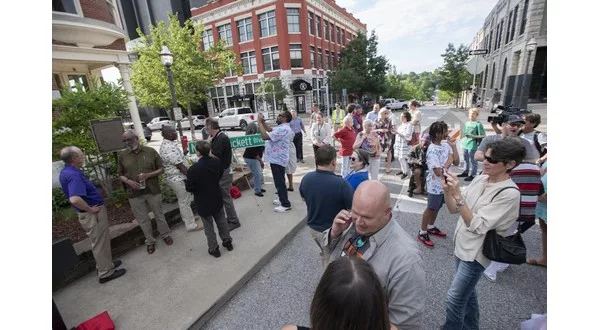
People gather during a dedication ceremony on the Fayetteville square renaming Archibald Yell Boulevard to Nelson Hackett Boulevard on Friday in Fayetteville. Hackett was the first and last slave to be extradited from Canada back to the United States. A marker telling his story was installed Friday in the flower bed at the northwest corner of the downtown square, in front of the Bank of Fayetteville, the Northwest Arkansas Democrat-Gazette reported. (Photo courtesy of Northwest Arkansas Democrat-Gazette via Associated Press)
FAYETTEVILLE, Ark. (AP) – An enslaved man who fled Arkansas in 1841 seeking freedom in Canada, only to be forcibly returned to the U.S., has been honored with a historical marker and a new street sign in the city where he once labored.
The unprecedented 1842 extradition of Nelson Hackett from Canada on a theft charge sparked an uproar in the British colony, which had long been viewed as a safe haven for escaped slaves. Months later, the British government enacted policies that “made similar extraditions extremely difficult,” according to the Nelson Hackett Project, a digital work of public scholarship helmed by the University of Arkansas Humanities Center.
Canada never sent another fugitive from slavery back to the U.S., researchers said.
A marker honoring Hackett and his impact was installed Friday in Fayetteville’s downtown square, the Northwest Arkansas Democrat-Gazette reported.
Archibald Yell Boulevard is being renamed Nelson Hackett Boulevard, the newspaper reported, an especially symbolic action given the role that Yell, who served as Arkansas governor at the time, held in securing Hackett’s extradition. The new street signs, also unveiled Friday, are scheduled to be installed Monday on Juneteenth.
Hackett fled Arkansas in July 1841, prompting the man who claimed to own him to demand his extradition on charges of theft, according to Michael Pierce, associate history professor at the University of Arkansas at Fayetteville. Yell wrote a letter to the colonial governor of Canada requesting Hackett be returned. The request was granted.
Hackett was brought back to Fayetteville in the summer of 1842. He was publicly whipped several times, tortured and sold back into slavery in Texas, according to researchers. He escaped again, and his fate remains unknown.
Hackett labored near where the marker is displayed on the square. The marker and the renamed street serve as a way to remember Hackett’s experiences, Mayor Lioneld Jordan said.
J.L. Jennings is chairman of the city’s Black Heritage Preservation Commission, which recommended the City Council change the name of the street and place the marker at the square. He said the commission has been working to highlight the city’s untold history and to increase feelings of belonging for all residents.
“We believe honoring Nelson Hackett is an important first step in this goal,” Jennings said. “It’s remarkable to think an enslaved Mr. Hackett could have actually stood here, where his marker is installed today, unknowing of the impact that his life would have on the world. While we do not know how Mr. Hackett’s story ended, what we do know is his impact was felt by thousands.”
WebReadyTM Powered by WireReady® NSI










